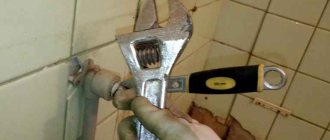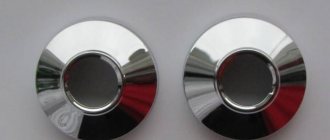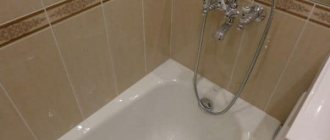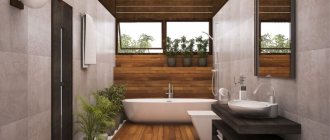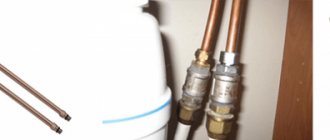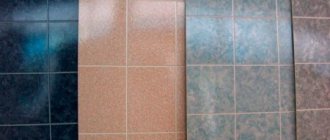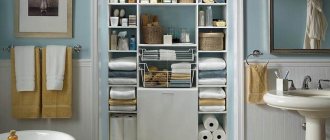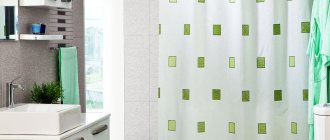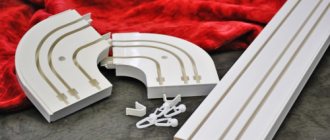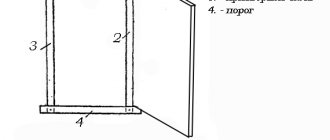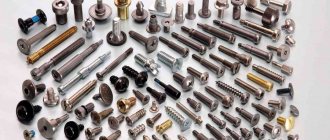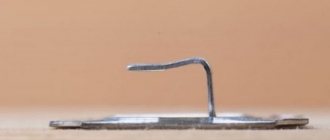Correct installation of plumbing fixtures involves the use of special adapters. A small eccentric for the mixer ensures its reliable connection with the pipelines of the hot and cold water supply system. The part is necessary when installing or replacing equipment. Imported and Russian mixers are manufactured to different standards and have dimensional tolerances, which are compensated by installing an eccentric.
Products of this kind are produced by industry in a very wide range of standard sizes. The eccentric for the mixer is made from different materials, and accordingly differ in technical characteristics and physical and chemical properties. The most important of them are precision manufacturing and resistance to hot and cold water. When choosing an eccentric, many factors are taken into account, primarily the connecting dimensions of the water fittings.
Installing eccentrics and mixer
Using the detailed instructions included with the product, you can easily figure out how to install the eccentrics for the mixer; it’s not difficult. First of all, the flax or fluoroplastic thread should be wound carefully and as tightly as possible along the thread. Apply silicone sealant or oil paint on top of it; it is permissible to use a paste intended for threaded connections. However, this action is desirable, but not required.
The eccentrics must first be installed manually, carefully observing that there is no misalignment. Only after making sure that the connection being made is high quality can you use a wrench or adjustable wrench for final tightening. The eccentrics should be level and without distortion, and their position should ensure a convenient connection with the mixer nuts. It is best to check horizontality using a level. The included decorative screens are screwed on by hand.
Often paronite, silicone or ordinary rubber gaskets are included with the purchased plumbing product. When using the first type, it is recommended to soak them in cold water for a few minutes before use. First, you should “bait” the mixer by carefully tightening the nuts by hand. After making sure that there is no distortion and that the threads are well threaded, use an adjustable wrench to tighten the nuts to the end.
Using additional devices
Most often, eccentrics are purchased complete with a mixer, and if additional gaskets are included with them, then you don’t have to think about insulation. If the gaskets are made of paronite, then before use, it is recommended to immerse them in a container of cold water for several minutes. If they are made of materials such as silicone or rubber, then they can be attached without resorting to any additional preparation.
After this, the tap can be tightened manually by tightening all the nuts using an adjustable wrench. This is necessary to ensure correct installation on the thread. If necessary, you can not only lengthen the eccentrics of the mixer, but also adjust, tighten and adjust its location in every possible way.
For example, if after installation a leak is detected in the water connection, this indicates that the nut is not tightened well enough. If the leakage does not stop after fixing the problem, the cause should be looked for in the quality of the gaskets used.
Installing a faucet on the side of a bathtub
There are quite a few models of faucets designed for installation directly on the bathtub. However, the possibility of installing them in each specific case is limited by the number of holes in the side. However, almost any model is suitable for an acrylic bathtub, since drilling it with a crown will not be difficult. As an example, install a four-hole faucet.
- Drill holes in the side, observing the distance recommended by the manufacturer, and then carefully clean them.
- In one of the outer holes - at your discretion - secure the socket for the watering can, placing spacers on both sides.
- Insert the mixer body into the middle of the three free holes, on the bottom side of the side, and screw the spout to it, not forgetting about the gaskets; secure the structure with a fastening nut.
- Install hot and cold water taps in the remaining holes in the same way, and then use the included flexible hoses to connect them to the mixer.
- Use long hoses to connect both taps to the appropriate water supply systems.
- Connect the shower to the mixer and carefully, being careful not to bend the liner, put the bathtub in place.
rmnt.ru, Igor Maksimov
First meeting
Let's start with the fact that an eccentric furniture tie is one of the types of furniture fittings that is used for assembly.
Structurally, the element consists of:
- racks;
- eccentric;
- futorka
The stand is also called the stem. Its role is played by a self-tapping screw or screw. And the foot in this mount performs the tasks of a nut.
Some kits, including eccentric couplers from Hettich, also include a bushing. It is also called a coupling. Allows you to screw the rod not into plastic, wood or chipboard, but into the bushing itself.
If the screed has a large diameter, then a decorative plastic plug for the front side is added to the kit.
Thanks to the bushing, wear resistance and strength can be increased. Due to the use of metal, the structure will be less loose than a hole made in chipboard. So I advise you to take accessories that have a coupling. With such a screed, the furniture will last much longer, and it will also be possible to avoid damage.
The operating principle is simple. This is a double-sided fitting. A coupling is inserted into a round hole made in the furniture. The stands are screwed into it. And the eccentric already connects them from the side. If a visually unsightly element remains on the top side, then it is simply closed with a plug.
One more thing. Eccentric furniture tie has 2 other names. These are rastex and minifix.
That's sorted out.
We can move forward according to plan.
Preparation for installation
To install the mixer, you need to purchase a complete device. The set includes: body, spout, eccentrics, shower hose and shower head, fasteners, seals
The main thing you need to pay attention to when choosing a device is the distance between the centers of the fittings for connecting the water supply pipes. GOST 25809-96 provides a distance of 100 and 150 mm
Water pipes are not always routed perfectly, so eccentrics are included with the mixer; with their help, you can adjust the distance by 1-2 cm.
Adjusting the center distance using eccentrics.
The only installation tool you will need is an adjustable wrench. And to waterproof the connections you need FUM tape, plumbing flax or thread.
Characteristics
Thus, an eccentric is a plumbing adapter for installing a faucet in a bathroom, allowing you to match the dimensions of the parts. These products are always sold in pairs, and the price is usually indicated per set.
Based on operating conditions, its most important characteristics will be:
- dimensions;
- design features (internal or external thread arrangement);
- corrosion resistance;
- a distance that the installation of an eccentric can help compensate for;
- rigidity and strength, allowing its installation without the risk of destruction;
- aesthetic qualities (how well the selected detail fits into the overall design of the bathroom).
It is these characteristics that you should pay special attention to when choosing the desired model of this fitting. The price range for products is from 200 to 2000 rubles, depending on the material, manufacturer and size.
Features of eccentric furniture screeds, installation rules
In the production of furniture, various types of fasteners are used, which ensure the reliability and durability of the structure. The eccentric furniture tie has become the most common in recent years. It is also known as “minifix” or “rastex”. An eccentric tie allows you to fasten elements at different angles, assemble and disassemble products several times. Furniture assembled using such an element is incredibly durable.
- Scope of application
- Materials and equipment
- Installation Rules
Scope of application
In addition, eccentric furniture ties are used to fasten parts where it is not possible to drill holes. For horizontal elements, such as shelves, it is more convenient to use plastic ties. Bulky structures are assembled using reinforced eccentrics.
Such fasteners are placed in the housing and contain an additional fitting.
The furniture is connected in such a way that the minifixes remain almost invisible. They can only be seen from the inside of the product. This point can be considered an advantage of this type of fasteners, since they do not spoil the appearance of the furniture. The eccentric tie makes assembly of products simple, quick, and also adds additional rigidity to the entire structure.
Materials and equipment
The eccentric coupler consists of 3 elements: a stand, an eccentric and a fitting that acts as a nut. There are several types of fasteners, which can be divided into groups depending on the material of their manufacture, the length of the stand, diameter, size, type of fastening of the self-tapping screw and fitting.
If you often disassemble and reassemble furniture, this type of fastener will be the best option. It is ideal for products made from chipboard and chipboard.
Reflectors for heated towel rails
The reflectors are made in such a way that their internal diameter coincides with the thread diameter. But they rarely have to be put on the thread itself. Much more often - on the very surface of the extension cords. Therefore, 3/4" collapsible reflectors fit perfectly into the outside diameter of 1/2" threaded extensions. But to fit them onto 3/4″ threaded extensions, you need to trim and fold the inner edge slightly, as in the photo.
This is done with metal scissors and pliers with thin jaws. Try not to unnecessarily bend the thin edge of the junction of the two halves of the circles. It will withstand two or three bends, but no more, and with a high degree of probability it will break.
This is what happened in the end. Heated towel rail with eccentrics and reflectors.
Installation of eccentrics
Replacing an installed faucet, like all similar operations, first begins with turning off the water, otherwise repair work will have to be carried out not only at home, but also at the neighbors below.
Then you need to unscrew the mixer from the eccentric, after which you can unscrew the installed fitting itself. Usually, due to prolonged use and contact with chlorinated water, its material becomes brittle and the thread “sticks”
If you still can’t unscrew the old part, you can slightly warm it up with a match or lighter.
After this, you need to wrap a sealing layer of flax or plumbing tape around the end of the extension cord that will be connected to the water supply. Then you can screw the parts into the leads and adjust the desired distance between the eccentric leads. First, it is checked with a ruler, after which you must attach the mixer itself to the terminals of the installed fittings and check that the axes and dimensions of the fastening match. Only then can final operations be performed.
After this, reflectors are installed. And finally, the mixer is connected, which can now be clamped with a key.
Additionally, this assembly can be sealed using silicone or any other paste-like sealant. In extreme cases, oil paint can be used.
Things to remember
- Before starting work, you must ensure that the crane is complete. Check for defects in parts and their dimensions.
- Make sure the eccentric dimensions are correct.
- Remember that flax or insulation should be screwed only in the direction of the thread.
- Check the tightness and reliability of the fastening of the insulation. It should not scroll along with the thread.
- Be sure to use a lubricant over the flax. An excellent option is silicone sealant or oil paint.
- First, you need to tighten the eccentric manually, then use the key.
Dismantling and installation of plumbing fittings
To install plumbing equipment, you will need a set of wrenches, FUM tape or tow. Installation of eccentrics for the mixer is carried out in the following order:
- A sealing material is screwed onto the external thread.
- The eccentrics are screwed into the fittings of the water supply system and tightened.
- The position of the free pipe is set so that they coincide with the connecting surfaces of the mixer.
- The plumbing fixture is attached to the pipelines using union nuts.
You can buy a short eccentric for a mixer without any problems and it allows you to quickly perform this operation. This kind of work can be done by any man who has minimal skill in handling tools. Installing the mixer using eccentrics takes no more than half an hour. In this case, the design features of the devices should be taken into account.
When installing a mixer with pipes, you will need an appropriate adapter. An eccentric with an internal thread for the mixer must be purchased in advance so as not to delay the work. Such devices allow the use of sealing gaskets instead of tape. Reliable installation of the mixer using such an element will eliminate the occurrence of leaks from the water supply system.
Fitting
To assess the general situation, you must first try it on. Eccentrics are screwed into water sockets, reflectors are screwed onto eccentrics, and a faucet without gaskets is screwed onto eccentrics.
What are we assessing? The first point is the alignment of the water sockets, or in other words, the screwed-in eccentrics should not stick out in different directions, their ends should be in the same plane. If the deviation is too large, the union nuts of the mixer will be screwed on with force - this is bad!
There are two ways to solve the problem of poor alignment of water sockets: correct the position of the water sockets themselves (which is very problematic when the tiles are in place) or tricky by “sawing” one eccentric to another (more on this below).
However, unevenly aligned water sockets are a rare occurrence, considering that the deviation can be leveled out with a threaded connection and gasket. The problem will be obvious only if the eyeliner is installed very carelessly.
During fitting, you should pay more attention to the position of the reflectors. If the water sockets are flush with the wall or stick out, the reflectors may not press tightly against the wall
The size of the eccentrics and the depth of the reflectors greatly influence here. If the reflectors are not adjacent to the wall, there are two ways - shorten the eccentrics or look for deeper reflectors in stores. If there are leads sticking out of the wall, you will have to do both.
Digressing a little on the topic of installing water sockets, I’ll note: the optimal position is when the internal thread of the outlet is slightly recessed into the wall (into the tile), about 5-7 mm. There is no answer with exact dimensions; different faucets have different sizes.
The ideal position would be when, during fitting, the reflectors are pressed tightly against the wall, and the mixer union nuts (without spacers) are screwed to the base of the reflectors with virtually no gaps. Keep in mind that when sealing the threaded connections, the eccentrics will screw in a little less, and the rubber gaskets will fit into the mixer.
Popular eccentric failures
When unscrewing an old brass eccentric, it happens that the thread stuck to the pipe and broke off.
To pull it out, you need to arm yourself with a hacksaw blade, a hammer and a flat-head screwdriver:
Use a hacksaw blade to make the first cut stuck inside the thread.
You must act carefully so as not to damage the internal threads of the pipe. Control of the process is necessary: having finished cutting to the right moment, resistance will be felt
Brass is much softer than metal. After retreating 5 mm, make a second cut. Carefully insert the end of a flat-head screwdriver between the sawn sector and the internal thread of the angle at an angle of 15 degrees, and gently hit the screwdriver with a hammer to disconnect the stuck thread of the adapter. Use pliers to pull out the remains. You need to make sure that the pieces do not fall into the pipe. If this happens, they can be removed by abruptly turning on the water. If, by carelessly knocking out the broken sector, the thread of the pipe is damaged, then screw in a new adapter, then unscrew it, wrap the seal with sealant or lubricant and screw it in again.
Installing or changing water eccentrics for mixers does not require special skills and can be easily done with your own hands. This requires conventional tools, sealing materials and the correct selection of eccentrics.
This is interesting: Selecting the optimal dimensions of a cast iron bathtub
Dismantling
Replacing an eccentric in a bathroom begins with dismantling outdated or unusable equipment. Carrying out the work in this sequence will allow you to correctly select a new device, taking into account all the features of pipe supply and the wishes of the customer.
How to unscrew the eccentric? It is recommended to perform the work in the following sequence:
- shutting off the water supply. If you do not first shut off the flow of water to the mixer, then replacing the eccentrics will lead to flooding of the bathroom and neighbors living on the lower floors;
- disconnecting the shower hose from the mixer;
- dismantling the mixer. To perform this work, it is necessary to loosen the nuts securing the device using an adjustable wrench or wrench of the appropriate size;
Removing the faucet in the bathroom
- removing the reflector - a special decorative device that covers the junction of the pipes and the mixer. The reflector is installed by screwing onto the eccentric. Therefore, to dismantle it, it is enough to unscrew the device;
- dismantling (unscrewing with a wrench) eccentrics.
Unscrewing the device from the pipe
Unscrewing the eccentrics from the pipes must be done extremely carefully so as not to damage the threads on the pipes.
After completing work on removing the eccentrics, it is necessary to clean the walls, pipes and other components from accumulations of dirt, rust and other types of contaminants.
Conclusion
Drawing a conclusion, we can say that the telescopic reflector is not only a decorative, but also a functional element of plumbing. It not only hides unwanted technical holes that cannot be avoided, but also allows you to maintain the rigidity of the installed faucet. But in order for this element to fulfill all its purposes, it is recommended to select them very carefully. First of all, this is quality control and packaging.
The applications for reflectors don't end with bathroom faucets. They can be found wherever they want to beautifully hide technological holes.
It is imperative to remember that the cheaper the product, the poorer the quality of the material from which it is made. The seller can easily mislead you in order to sell unnecessary, stagnant goods. For this reason, try to focus on the price yourself, understanding that if it is cheap, then, accordingly, it is of poor quality. It is also recommended to understand that very expensive and exclusive models will have a high cost, since they are made almost on an individual basis.
By following the above rules, you will definitely be able to purchase a telescopic reflector that will serve you for many years.
What do you need to know before installing a faucet in the bathroom?
Practically, all mixers have a connecting size of 1/2 inch and a distance between the axes of the tubes of 150 mm plus or minus 15 mm (see diagram below). These dimensions should be taken into account when installing the pipeline, and be sure to measure these distances from the mixer purchased in advance.
If the mixer is rotary, then we choose a place to install the mixer, also taking into account the rotation:
The height of the mixer from the finished floor is 120 cm.
However, you can determine the location for the faucet above the bathtub as follows: temporarily place the bathtub in the place where it should be. Then we draw a line on the wall vertically upwards exactly in the center of the bathtub, select the desired height, usually no more than 30 cm. We drill two holes with a center-to-center distance of 150 mm:
Holes are needed if you need to bring hot and cold water pipes from a room located behind a wall (partition) to the mixer; this is the layout in most apartments where the bathroom and toilet are separated by a wall. Usually the risers are located in the toilet, and the tubes go into the bathroom from there. If you have everything in one room (say, an old apartment with a shared bathroom or a private house where the bathroom is also shared for some reason), then, most likely, you don’t need to drill through the wall. I am hinting that you should proceed from your own situation and not blindly copy. But since this article is only about installing a faucet in the bathroom, I will not tell you here how to install a water supply from different pipes, but will continue on the topic of the article.
The mixer kit includes gaskets, eccentric bushings and decorative cups:
Theory of the issue
When a master independently installs a mixer, he is faced with the following problem: the indicator of the distance that separates the pipes through which water is supplied and the same parameter for the corresponding tap pipes do not correlate. This leads to the fact that it is impossible to connect the mixer directly to the pipes.
It is for this purpose that this article discusses the question of what eccentrics are, since such devices, when rotated from one side to the other, allow the master to adjust the distance between two bushings.
Often, designs of this kind are already included in the purchased kit along with the mixer itself, so the installer does not have to “reinvent the wheel” - he just needs to read the instructions and act according to the recommendations specified in it.
It happens, however, that the kit is sold without such devices or the dimensions of the eccentrics are incorrect. In such a situation, you will have to purchase the installation mechanism separately.
Eccentrics included
If the design turns out to be shorter than you would like, you can purchase an additional adapter - it will help adjust the dimensions of the product.
Selecting a thread sealant
Rewinding is only needed for eccentrics.
The quality of installation of the mixer depends on how reliably the threaded connections are waterproofed. For this purpose use:
- Plumbing linen.
- Plumbing thread.
- FUM tape.
Linen is a time-tested material. Despite the emergence of many other methods of waterproofing, it is still popular among professional plumbers and amateurs. The quality of the seal is at a high level. Correct linen winding does not move when screwed in and is not cut by thread. The external bushing with flax winding can be adjusted in space, but by no more than ¼ turn.
To wind the thread, flax is twisted into a braid. Then they are wound tightly in one layer, so as to hide the thread. The tail of the thread must be clamped with the first turn. The direction of the winding should be opposite to the direction in which the part will be screwed. Then the flax will remain in place when connecting the threaded pair.
The only disadvantage of flax is that it is not slippery enough. It is imperative to use special plumbing lubricants (pastes) with it. They prevent the fibers from being cut when screwed in and allow the flax to crumple tightly along the thread, making the connection as reliable as possible. In addition, it protects flax from destruction under the influence of moisture.
Plumbing thread is a less common material for waterproofing threaded pairs, as it is quite expensive and has specific uses. The thread is wound not along the thread, but crosswise. The tail is also clamped with the first turn. The material is reliable and easy to use, ideal for small jobs. Allows you to twist the connection in the opposite direction up to half a turn.
FUM tape is a popular material among amateurs and professionals, as it is very easy to use and fix on the thread. The tape is wound in several layers - from 3 to 10, depending on the diameter of the threaded pair, the density of the connection without winding and the thickness of the tape itself. The winding should be done from the base of the thread to the edge. The tape is wound along the thread, pulling slightly. The end must be cut, not torn off. FUM tape is quite smooth, so it does not require the use of additional lubricant.
Consecutive stages of work
The next operation is to manually screw the long eccentrics to the structure. Make sure that the device is correctly aligned with the thread itself, only then screw it tightly using an adjustable wrench or wrench. It is better to perform several successive rotational movements with the tool. Carefully check that the flax threads that were wound directly onto the threads do not wrap around - this will disrupt the functionality of the entire structure. If this still happens, it is better to dismantle the entire system, remove any remaining flax from the threads, and then re-wrap it with a sealant.
After the faucet is installed, you can proceed to the installation of reflectors, which are also called decorative screens.
Technological features of the procedure
Installation of eccentrics for the mixer is an important component of its installation. The process is divided into two sequential operations:
- direct fastening of structures;
- tap connection.
Before you begin installation work, you must ensure that access to water is blocked. This will help prevent the possibility of unintentionally flooding your neighbors.
First, carefully assemble the structure completely without using a sealant. The procedure is necessary to make sure that the finished product will not have any distortions, and all mounted connections will seamlessly connect to each other. In a situation where you come across too short eccentrics, you can replace them with other analogues or purchase screens designed for structures.
Connecting the tap via eccentrics
Any device consists of two parts - a wider and a narrower component
During the installation process, after you have managed to carefully unscrew the old eccentric on the mixer, be sure to carefully wrap the short thread with flax
Such threads can be replaced with a fluoroplastic product - it can be a tape. In any case, the product must be wound so that it cannot under any circumstances scroll around the base.
A special paste is applied to the threads, intended for use when working with threaded connections. A sealant made from silicone is also suitable. If neither the first nor the second means is available, oil paint will do. As a last resort, leave the mixer untreated - by and large, nothing should happen.
Non-specialized concepts
This part has a round shape, in which the geometric axis and the axis of rotation coincide.
Application of eccentrics other than plumbing:
- for fastening furniture structures,
- in astronomical studies.
The device allows you to adjust the distance between two bushings. In some cases, it is not possible to complete the process without a device.
How can he help?
During the independent installation of the mixer, you may encounter a problem such as misalignment between the tap pipes and the pipeline. As a result, it is impossible to directly connect one to the other.
Often such devices are included in the kit together with the mixer. It is enough just to study in detail the instructions offered by the manufacturer and carry out the installation normally. If there was no eccentric in the kit, the part of the required diameter can be purchased separately, its price is completely affordable.
Tip: if the device in the kit is not the right length, you have the opportunity to buy an additional adapter that will allow you to adjust its dimensions.
How to install an eccentric
Installation of the faucet fixture is divided into two operations, performed sequentially:
- structure fastening,
- tap connection.
Advice: before starting installation work in an apartment building, make sure that you have shut off the water riser.
We recommend that you first assemble the entire structure without seals and make sure that all mounted connections are not distorted among themselves. For example, if you have too small eccentrics in your kit, you can replace them with suitable ones before starting the main work.
The device consists of two parts – narrow and wide. If you were able to carefully remove the old eccentric from the mixer during installation, replace the seal on its thread. Use hemp or fum tape, making sure that they do not roll around the base during the connection.
Tip: for hemp, use a special paste designed for threaded connections or silicone pipe sealant. As a last resort, use oil paint.
- Screw the long eccentrics to the liner, making sure that they correspond correctly with the thread. Tighten them well using an adjustable wrench or wrench. Make sure that the threaded seal does not turn around, otherwise it will impair the functionality of the structure.
- The instructions recommend installing the eccentrics so that the nuts of the mixer body can be comfortably and easily screwed to them. Make sure that the installation occurs smoothly, without distortions.
- At the last stage, attach decorative screens that will hide the connection point.
Tip: if the kit contains or you decide to install sealing gaskets, you have the option of not using the thread seal.
Material
There are different types of eccentrics for the mixer, but the main thing along with this is what they are made of:
What they are made of and the disadvantages of inexpensive models
Products can be made of bronze or chrome-plated metal. In most cases, inexpensive options from China and Turkey are chrome plated. We recommend not using metal products from the set, but replacing them with brass ones. Despite the fact that they look beautiful, they often “stick” to the threads with rust. Another disadvantage of inexpensive eccentrics is that when they are unscrewed from the water supply after some time, the head has a pipe thread
After this, getting it out of the pipe will be quite difficult and associated with unforeseen costs.
Please note: Choose only solid brass eccentrics. On sale now you can also find yellow products, but made from pressed brass powder. Their price is significantly lower than cast ones, but we do not recommend buying them due to their fragility
There is a high probability that at the moment of tightening the product. Do not forget that when installing an eccentric made of pressed bronze, there is always a danger that if there is accidental pressure on the faucet during operation, it may fall off the wall together with the mixer. The right choice This expert advice is suitable for selecting both an eccentric and a crane. “Weigh” the product in your hands – one of the most basic indicators of quality. Know that brass is a fairly heavy metal. Based on this, take the expensive option in one hand, and the one you want to buy in the other. You should not take the seller’s words on faith at a time when doubts have crept into your mind. The yellow color of the surface may turn out to be a simple coating, under which sintered aluminum chips or cast iron can hide.
Features of eccentrics
Eccentric for mixer
The design of the eccentric for the mixer is a tube with threads at both ends and with a shifted middle part. Adjustment of dimensions between joints is carried out thanks to this kind of transition. The name “eccentric” consists of two words: “ex” (outside) and “center”, which stands for “outside the center”. The part has two different thread diameters at the edges: wide and narrow. Their sizes are 15mm and 20mm. The standard distance between the axes of the inlets of water pipes is 150 mm.
There are several types of adapters: short, extended and long:
- Adapters with a small shoulder are standard designs of 3-4 cm, usually included with the mixer. In addition to the eccentrics, reflectors are provided - decorative overlays that hide the connections of plumbing fittings. With the help of such adapters, you can adjust the distance up to 8 cm.
- Products with an increased shoulder - are installed when pipes or other obstacles interfere with the installation of the mixer, and allow you to move the faucet from the wall to the required distance.
- Designs with a large shoulder distance - used when there is a significant difference between the outlet distances of water pipes and the mixer pipes.
The length of the eccentric arm is an important characteristic. It indicates the possibility of increasing the distance between the installation points of connection nodes
Products are available in sizes 40 mm, 60 mm and 80 mm. There are corresponding markings: M8, M10 and M12.
The most commonly used products are brass, bronze and stainless steel. According to consumer reviews, budget metal or brass options with a chrome finish are in great demand. Adapters made of brass are preferable, because No rust forms on threaded connections.
The disadvantage of inexpensive products is their fragility when unscrewed from water pipes.
Extensions made of powdered pressed brass, even with slight tightening, often burst and have the only positive quality - low price. Good brass adapters should be solid.
The high quality of eccentrics is guaranteed by well-known companies:
- Remer - extension cords produced by an Italian company. They are of excellent quality, but have a high cost: from 400 to 600 rubles, depending on the shoulder distance.
- Timo - adapters come complete with decorative overlays. Price from 600 rubles.
- Grohe - products made in Germany, made of brass, chrome plated. High quality adapter, price 2500 rubles.
The installation adapters supplied with mixers are generally not suitable in size or quality. Therefore, the purchase of a mixer also implies the additional purchase of eccentrics.
Kinds
Modern manufacturers present a wide range of products. On sale there are deep and flat, small and large, standard and designed for an individual line of mixers.
Conventionally, all reflectors can be divided into three types:
- simple;
- detachable;
- double
Simple ones are monolithic products and are attached even before installing the mixer. They do not interfere with installation work in any way.
Detachable products are considered more practical. They also do not interfere with the installation process at all and can be put on before or after they begin. Detachable ones are distinguished by the presence of a cut, which conditionally divides the reflector into two parts and allows you to put on the bowl after installing the mixer. Despite the fact that this cut is visually noticeable, it does not in any way harm the aesthetic properties of the product.
Double reflectors are used for cold and hot water supply. They feature a monolithic design with two holes. They are not as popular as the previous two types, and are produced for a specific type of mixer.
Attaching the shower head holder
How to attach the holder to the wall depends on what material it is made of. If it is concrete, then dowels and screws will be required. Installation steps:
- Mark the location of the fasteners on the wall. A pencil or marker is suitable for this. The holder must be placed at the installation site at the required height and marks must be made through the holes for fasteners. To prevent the drill from sliding on the surface of the tile, you need to slightly damage the smooth coating of the tile using a self-tapping screw or a pobedit drill. It should be placed in the center of the mark and knocked down with a hammer.
- Drill holes and insert dowels into them.
- Secure the watering can holder with self-tapping screws.
Installing a holder in a plasterboard wall lined with tiles is more difficult - you need to know the location of the rack profile or mount it in advance, at the stage of constructing the partition. Only in this case is the secure fixation of the holder guaranteed. The first two stages of installation in drywall are similar to mounting on a concrete wall. You only need to drill the tiles and the adhesive layer. In this case, the holder is attached to metal screws with fine threads.
This completes the self-assembly and installation of the faucet in the bathroom. All that remains is to turn the water supply valve and use the device for its intended purpose. If all the work is done correctly, the tap will not leak for a long time.
Some background information
For many years, in the domestic production of furniture made from laminated chipboard, a screw tie was used. In our country it is called “kon”, and in Europe it is called single-element or Einteilverbinder. Despite the low price of this screed, it has one significant drawback - the confirmation heads, even under the plugs, are very noticeable on the walls of the case. And this, in turn, makes it not of very high quality and attractive. Furniture assembled without visible fasteners looks more solid and beautiful and automatically belongs to a higher segment.
With the growth of the manufacture of cabinet furniture with one's own hands and the use of modern technologies, other types of high-quality ties began to appear on the market, differing in the principle of connection from the usual confirmation. Furniture eccentric screed is one of them. Among its advantages, it is worth highlighting the following:
Installing an eccentric coupler
Compliance with the installation dimensions is the main condition, the fulfillment of which guarantees the correct installation and the coincidence of all elements of the screed. The installation dimensions are the same for any type of screed. They are summarized in the table.
| Purpose of the groove | Size | Where is it performed? | What it does | |
| Diameter | Depth | |||
| under the eccentric | 15 (12) mm | 12.5 mm | On the surface of the part to be fastened | Forstner router and depth gauge |
| screw-on | 8 (6) mm | Determined by stem length: 24, 34 or 41 mm | From the end part of the part to be fastened, perpendicular to the hole for the eccentric, the center of the hole is at a distance of 8 mm from the edge of the part | drill with 8 mm drill bit |
| under the base of the screw | 5 mm | 11 mm | on the surface of the second part | drill with 5 mm drill bit |
| under the bushing (futorka) | 10 mm | 11 mm | on the surface of the second part | drill with 10 mm drill bit |
Installing an eccentric coupler involves three main steps:
- Marking grooves for screed elements.
- Addition of holes on the joined elements.
- Installation of minifixes - installation of an eccentric coupler.
The installation stage of minifixes was discussed in detail earlier
When connecting the elements of the coupler, you should pay attention to how the rod is located. If it is tightly screwed, it will not be possible to turn the eccentric all the way, in which case the parts will not be properly secured
If the rod is not tightened, this also negatively affects the quality of the connection.
Let's look at the description of the procedure for marking and adding grooves in more detail.
Scope of application
This type of fastening, such as minifixes, is used when it is necessary to hide fastening elements, for example, on a furniture facade. Due to the peculiarities of drilling grooves for screws and eccentrics, this method is common mainly for factory installation of furniture. But knowledge of the basic principles, the availability of specialized equipment and a little skill will allow a novice home craftsman to master this type of fastening.
The main purpose of an eccentric coupler is to connect parts at right angles. This connection happens:
- L-shaped;
- T-shaped.
The mechanism for connecting furniture elements using a minifix without a sleeve is as follows:
- A screw is screwed into a hole with a diameter of 5 mm on the surface of one of the elements being connected.
- The second element is put on the screw with a hole measuring 8 mm located in the end part.
- An eccentric is inserted into a groove on the surface of the second element, 15 mm in diameter.
- Using a screwdriver, the eccentric is rotated 180 degrees in a clockwise direction, securing the connection. A simple screwdriver, flathead or Phillips, or a hex wrench can be used.
The principle of fastening parts with a tie to a sleeve is similar. The difference is that the hole for the base of the screw is made with a 10 mm drill, in which a plastic sleeve is attached to PVA glue, into which the screw is screwed. The remaining steps are the same as when using a minifix without a sleeve.
Assembling furniture using this method, if you have experience in such work, is simple and quick.
Let's look at how this type of fastening works using the example of assembling a chest of drawers and the chest of drawers itself.
How to install eccentrics for a bathroom faucet
To understand this process, you need to carry out all the work in stages
First of all, you need to pay attention to the correct relationship between the threads of the eccentric, tap and pipes. Only after this can you begin the tightening process, which is carried out using a wrench or an adjustable wrench.
In this case, special attention should be paid to the sealing winding. It should not rotate along the thread, otherwise the functionality and tightness of the entire structure will be impaired. If you notice scrolling of the flax or fum tape, it is necessary to dismantle it and re-wind it more tightly.
When installing eccentrics, you need to ensure their most convenient location for screwing the nuts of the mixer body
It is also worth paying attention to the level of their location, which will guarantee evenness of installation without distortions. After all this, you can start arranging the decorative reflectors of the mixer
Additional accessories
It should be noted that some manufacturers of plumbing equipment come with a set of special gaskets along with a set of mixer and eccentrics. In this case, there is no need to use additional seals
Important! If the gaskets are made of paronite, it is recommended to briefly place them in cold water before installation. When it comes to rubber or silicone models, such preparation is not required
Recommendations and advice for the master
Before you begin installing the mixer, you need to unpack and assemble the kit into a single unit. This will ensure that there are no manufacturing defects;
Quite often, the eccentrics that come with the kit may not be the right size. Because of this, for correct installation you will have to buy others;
When wrapping a thread with a sealant, wrapping should be carried out only in the direction of the threaded turns;
The eccentric must be tightened manually to ensure that it fits correctly onto the thread. Only after this do they press with a key;
The installation must be thoughtful to ensure comfortable screwing of the nuts of the mixer itself
Particular attention is paid to the accuracy and level of installation, which will avoid distortion
Conclusion
In conclusion, it must be said that an eccentric is a unique connecting element that is used when installing faucets and other plumbing fixtures in the bathroom. As a rule, the use of such elements during installation is provided by the equipment manufacturer itself. If necessary, you can select these elements by length and diameter.
The above shows how to install eccentrics for a faucet in the bathroom with your own hands. Our recommendations and installation tips will allow you to create truly reliable systems with a long service life.Source
Non-specialized concepts
This part has a round shape, in which the geometric axis and the axis of rotation coincide.
Application of eccentrics other than plumbing:
- for fastening furniture structures;
- in astronomical studies.
The device allows you to adjust the distance between two bushings. In some cases, it is not possible to complete the process without a device.
How can he help?
During the independent installation of the mixer, you may encounter a problem such as misalignment between the tap pipes and the pipeline. As a result, it is impossible to directly connect one to the other.
Often such devices are included in the kit together with the mixer. It is enough just to study in detail the instructions offered by the manufacturer and carry out the installation normally. If there was no eccentric in the kit, the part of the required diameter can be purchased separately, its price is completely affordable.
How to install an eccentric
Installation of the faucet fixture is divided into two operations, performed sequentially:
- fastening the structure;
- tap connection.
- We recommend that you first assemble the entire structure without seals and make sure that all mounted connections are not distorted among themselves. For example, if you have too small eccentrics in your kit, you can replace them with suitable ones before starting the main work.
The device consists of two parts – narrow and wide. If you were able to carefully remove the old eccentric from the mixer during installation, replace the seal on its thread. Use hemp or fum tape, making sure that they do not roll around the base during the connection.
- Screw the long eccentrics to the liner, making sure that they correspond correctly with the thread. Tighten them well using an adjustable wrench or wrench. Make sure that the threaded seal does not turn around, otherwise it will impair the functionality of the structure.
- The instructions recommend installing the eccentrics so that the nuts of the mixer body can be comfortably and easily screwed to them. Make sure that the installation occurs smoothly, without distortions.
- At the last stage, attach decorative screens that will hide the connection point.
Material
There are different types of eccentrics for the mixer, but the main thing along with this is what they are made of:
What they are made of and the disadvantages of inexpensive models Products can be made of bronze or chrome-plated metal. In most cases, inexpensive options from China and Turkey are chrome plated. We recommend not using metal products from the set, but replacing them with brass ones. Despite the fact that they look beautiful, they often “stick” to the threads with rust. Another drawback of inexpensive eccentrics is that when they are unscrewed from the water supply after some time, the head has a pipe thread. Getting it out of the pipe after this will be quite difficult and associated with unforeseen costs
Please note: Choose only solid brass eccentrics. On sale now you can also find yellow products, but made from pressed brass powder. Their price is significantly lower than cast ones, but we do not recommend buying them due to their fragility
There is a high probability that at the moment of tightening the product. Do not forget that when installing an eccentric made of pressed bronze, there is always a danger that if there is accidental pressure on the faucet during operation, it may fall off the wall together with the mixer. The right choice This expert advice is suitable for selecting both an eccentric and a crane. “Weigh” the product in your hands – one of the most basic indicators of quality. Know that brass is a fairly heavy metal. Based on this, take the expensive option in one hand, and the one you want to buy in the other. You should not take the seller’s words on faith at a time when doubts have crept into your mind. The yellow color of the surface may turn out to be a simple coating, under which sintered aluminum chips or cast iron can hide.
Varieties
There are different types of elements, primarily they differ in the materials used in production. A budget eccentric for faucets, made of metal or brass and chrome-plated, has become quite widespread. Brass products, despite their less attractive appearance, are more preferable, since they do not form rust in threaded connections. Among the disadvantages of inexpensive eccentrics, it is worth noting the high probability of breaking off when unscrewing from water pipes. This leads to additional expenses and complicates the progress of work.
The best option is a solid brass eccentric. Low-cost bathroom faucets are often equipped with yellow-colored products that are made from pressed powder material. They often burst when tightened, are highly fragile and have the only advantage - low cost.
During operation of the faucet, even under slight pressure, it can break off from the wall due to the use of powdered brass products.
Materials
Plastic
Plastic products are lightweight, easy to install, and come in a variety of colors. They are not afraid of corrosion and fit tightly to the mixer. The most in demand are plastic products that look like metal. However, the coating quickly deteriorates and becomes unsightly. In addition, when exposed to hot temperatures, bowls quickly lose their shape, and the plastic begins to release odors and toxic substances. Consequently, plastic reflectors cannot be called practical and reliable.
Chrome or nickel plated steel
With proper care, such products do not lose their appearance and do not peel off. Their weak point is their low resistance to corrosion and after some time the product will begin to become covered with brown spots of rust. Conscientious manufacturers apply thick layers of topcoat to protect products from the harmful effects of moisture. However, such bowls will cost an order of magnitude more.
Stainless steel
Durable and practical products with an optimal price-quality ratio. They can last for many years without deformation or rust. They tolerate high humidity well and do not lose their shine.
Alloys of bronze, brass and copper
Non-ferrous metals are rarely used for the production of reflectors and, as a rule, such products are more often found among limited editions of famous brands.
